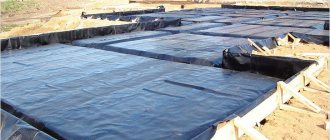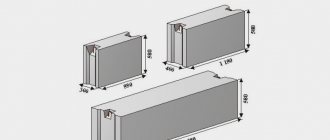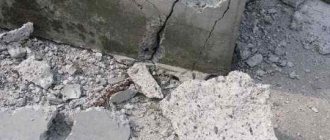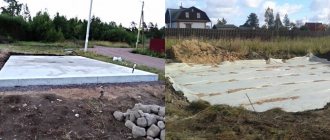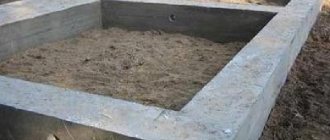This physical quantity that needs to be calculated for the foundation depends on many parameters. The calculation of the depth indicator is influenced by the features of the relief surface, the location of the construction site, the design features of the planned building, the depth of soils that can be frozen, the level of groundwater in a given area, and others.
Professional calculation, of course, is very important, but many who are building a private house cannot afford to calculate the depth of the foundation for a house in a construction company.
This article is for people who are building their own house, due to circumstances, cannot pay for the services of professionals and want to do this calculation themselves.
What it is?
The depth of the foundation is the distance from the base to the surface of the earth.
In fact, this is the height of its underground part, which determines the location of the supporting platform and the area of the side, recessed foundation walls.
By changing the depth, you can solve the following problems:
- Increasing the stability of the structure by increasing the area of the underground part with lateral support on the ground.
- Increasing load-bearing capacity by increasing the size of the base.
- The optimal location of the contact area between the foundation and the ground, which makes it possible to install the base on the most durable and stable layer.
The rules for determining this parameter are established by regulatory documents: SNiP 2.02.01-83 and SP 22.13330.2011.
What does it depend on?
The design depth of the foundation, in general, depends on the geological, hydrological, climatic and structural features of the area, site and the building itself.
The following factors have the most significant impact:
- Purpose of the structure and features of its operation.
- Design factors: size of the structure, type of foundation, number of floors, presence of a basement, location of utilities.
- The load on the foundation, determined by the total operational weight of the structure, as well as the mass of snow accumulation.
- Soil properties: type and structure, stability, heaving, moisture, etc.
- Soil freezing depth.
- Depth of groundwater.
- Climatic factors: degree of wind load, seismicity, flood situations, etc.
- Relief of the site.
There are general rules for determining the depth of the foundation, but each type of foundation also has certain nuances. Various methods are used for shallow and buried foundations.
Soil freezing
One of the most important influencing factors is the depth of soil freezing . The fact is that when freezing, the water in the soil expands, increasing its volume. As a result, the foundation begins to experience additional load from the soil.
If it is not so dangerous for the side, reinforced walls, because... is extinguished due to the high strength of the structure, then a force appears from below aimed at pushing out the support.
The magnitude of such a load depends on the heaving of the soil, i.e. the degree of its expansion upon freezing . Accordingly, in the spring, when thawing occurs, the reverse process occurs. As a result of annual fluctuations, the foundation material gradually deteriorates, reducing the durability of the building.
These processes occurring in the freezing zone require that the foundation base on heaving soils be located below the freezing level. In low-heaving soils (sandstones, rocky outcrops, etc.) the impact is less significant and a shallow foundation can be used.

The depth of soil freezing is determined based on the results of long-term observations and varies for different regions of the country. It depends on the average daily temperature and soil type.
So in the Moscow region, with an average daily temperature of minus 10⁰C, the freezing depth is:
- clays and loams – 78 cm;
- sandy loam and dusty sand – 95 cm;
- medium and coarse sand, gravelly soil - 1 m;
- coarse-clastic soils – 1.16 m.
Average data on the level of soil freezing in different regions of the Russian Federation are given in SNiP 23-01-99 and SP 131.13330.2011. Based on them, a map of the entire territory is drawn up.

During the operation of buildings, changes in the freezing process may occur due to heat flows.
The freezing depth is adjusted using the formula: H = mx But, where:
- But – standard (tabular) freezing depth,
- m – coefficient of influence of the thermal regime of the structure, incl. heating devices.
The coefficient ranges from 0.4-1.1.
If tabular data is not available, then the freezing depth can be calculated using the formula: H = Hi√Mt, where:
- Hi is the standard freezing depth of a certain type of soil,
- Mt – average monthly subzero temperature in winter.
Foundation resistance to frost
It is known that a good indicator for deep foundations is resistance to frost heaving. This is the name given to the process of groundwater pressure on the foundation material. Frozen soil, already at zero temperature, begins to expand and affect the foundation walls, creating cracks in them.

Rice. : Foundation resistance to frost
During a repeated cycle of thawing and freezing, water enters through them into the foundation blocks, causing so-called frost heaving of the foundation. Such processes are excluded in foundations with a deep laying level, since they are calculated at a level below the soil freezing mark.
Determination of depth
When building a house, the question arises: how to determine the depth of the foundation? For a buried foundation, there is the following rule: it should be 20-30 cm greater than the freezing depth and 50-60 cm less than the depth of groundwater. The choice of parameter value is little influenced by structural and operational loads.
For economic reasons, it is believed that it is advisable to build a strip foundation with a laying depth of up to 2.5 m. For larger values, it is better to use a columnar or pile type.
A shallow foundation has a depth of about 35-50% of the freezing depth. This option is typical for a monolithic slab in any soil, as well as a strip or columnar foundation when building on low-heaving soils.
The foundation depth is calculated taking into account the loads from the structure and the bearing capacity of the soil . The depth of freezing also makes its own adjustments, but through practical recommendations.
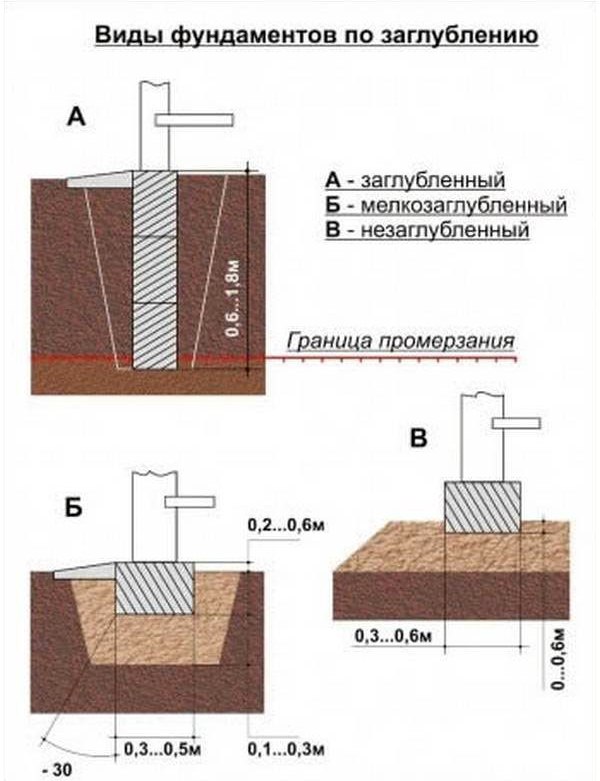
Formula for calculation
How to calculate the depth of the foundation for a house? The calculation is carried out in accordance with SP 22.13330.2011 using the formula.
Formula for calculating freezing depth
Н = Hi√Mt
- N - freezing depth,
- Hi is the standard freezing depth of a certain type of soil,
- Mt – average monthly subzero temperature in winter.
The Hi value is:
- 23 cm in clays,
- 28 cm in dust type sandstone,
- 30 cm in coarse sandstone,
- 34 cm in rocky soils.
Example
Let's consider the construction of structures on clay soils in the Moscow region. Moscow is characterized by average temperatures: December – minus 10, January – minus 16, February – minus 18⁰C. Then we calculate the freezing depth: Н= 0.23√(10+16+18)= 1.1 m.
The adjustment is made taking into account the coefficient of influence of the thermal regime of the structure m . Its value is established by SNiP 2.02.01-83 and SP 25.13330, taking into account the average daily temperatures maintained in the room.
In these documents, you can use the table to clarify m for buildings with different modes of residence, different floor structures, taking into account the presence of insulation and a basement.
For a house with an insulated base in the Moscow region, with an average daily room temperature of 10-12⁰C, m = 0.9 can be taken.
Finally, the calculated freezing will be: N x m = 1.1 x 0.9 = 0.99 m.

Depth of foundations in accordance with the requirements of Table 2 of SNiP 2.02.01-83*
Next, you need to take into account the location of groundwater . If they are located at a depth of more than 3 m, then the depth of the foundation must be no less than the freezing depth.
Taking into account the recommendations, the depth is assumed to be H+0.3 m, i.e. 1.3m. This depth should ensure the reliability and durability of the strip or column foundation.
Minimum and maximum values
For a buried foundation, the minimum depth is equal to the depth of soil freezing, and the maximum depth of the foundation should not reach groundwater by at least 0.5 m.
The minimum laying of a shallow foundation is established by SNiP 22.13330.2011, taking into account freezing in the following dependence:
- non-heaving soils with freezing up to 2 m or slightly heaving soils with freezing up to 1 m - the foundation depth is at least 0.5 m;
- when the specified soils freeze within 2-3 and 1-1-1.5 m, respectively - 0.75 m:
- when freezing more than 3 m and within 1.5-2.5 m, respectively - 1 m;
- when slightly heaving soils freeze to a depth of more than 2.5 m - 1.5 m.
The temperature inside the house allows you to adjust the depth of a shallow foundation.
So for an unheated house in the Moscow region, the minimum foundation depth is 0.5 m. If the average daily temperature in the room is maintained at least 10 degrees throughout the year, then the minimum depth is 0.4 m, and at a temperature of 20 degrees - 0.28 m .
The minimum values given are for one-story buildings . When constructing a 2-story structure, they should be doubled. Taller buildings are not erected on shallow foundations.
When building on high-strength soils (rocky outcrops, coarse soils), the foundation is intended only to redistribute loads evenly over the entire area.
The minimum foundation depth is 0.3 m. The depth for a monolithic slab foundation is selected in the same way.
MZLF technology or how to make a shallow strip foundation with your own hands
The instructions are easier to understand if all the work is divided into clear steps. Let's not deviate from this scheme. So, the structure of a shallow shallow foundation is as follows:
Preparatory stage
We will assume that before this stage you have made a house design, decided on the quality of the soil and the type of foundation, and also taken into account everything stated above.
1. The place where it is planned to pour the foundation is cleared of all unnecessary things.
Advice. Uproot trees that are nearby along with their roots.
2. All necessary materials and tools are delivered to the workplace. Moreover, it is advisable to immediately determine the location of all this stuff, so as not to waste time searching for it later.
Marking for strip foundation
The importance of this stage is difficult to overestimate. Therefore, you need to not only “estimate” where you will dig a trench, but also make landmarks using a rope (if possible, a laser level would be better).
How to make markings for the foundation:
- take measurements around the perimeter;
- put beacons in the corners;
- check the diagonal between the corners;
- if necessary, move the beacons;
- make a blind area at a distance of at least a meter from the beacons;
- Attach a rope to the blind area boards, which will show the edges of the foundation.
The marking process is presented more clearly in the diagram.

Marking for strip foundation - diagram
How to dig a trench for a foundation

Foundation Trench A foundation trench is a strip of excavated soil.
The depth of the trench is determined by the depth of the shallow strip foundation and cushion.
Foundation trench slopeFor example, the most common depth is 300 mm, the thickness of the pad is about 200 mm, depending on the quality of the soil. Then the depth of the trench will be 500 mm.
Advice. To prevent the edges of the trench from crumbling, make small slopes.
Considering the type of soil, it is better to start pouring the foundation immediately. Otherwise, it will crumble and some of the work will have to be repeated.
Pillow for strip foundation
The sand cushion for the foundation is a mixture of sand and gravel. You can mix them, but it’s easier to pour them in layers. Moisten each layer with water and compact well. Since the structure of the pillow is quite porous, it is separated from the main foundation with a waterproofing film.
In principle, natural soil can serve as the basis for a shallow strip foundation, but its bearing capacity is much lower than the proposed sand and gravel cushion.

Pillow for strip foundation
Formwork for strip foundation
Install the entire formwork structure vertically. The supports are attached in increments of 500-600 mm. They are needed to ensure that the formwork does not fall apart or warp under the weight of the concrete.

Formwork for strip foundations Useful advice. Try to keep the boards adjacent to each other tightly and without sudden changes. Then you will avoid work on leveling the surface of the finished foundation for cladding.
Pouring strip foundation
Obtaining concrete is an individual matter - you can buy (or rather, order) and the concrete will be delivered with a mixer, or you can make it yourself, using a homemade concrete mixer (and the second option is how to make a concrete mixer from a washing machine).
As for pouring concrete, the procedure is standard for such work - concrete is poured into the finished formwork.
Advice. If the formwork is watered, the concrete will lie more evenly around the edges.
When pouring concrete, try to beat it every 40-50 mm. height. This will “expel” air bubbles that could destroy the concrete in the future.
Reinforcement of a shallow strip foundation
If the foundation is not expected to bear a heavy load, this step can be skipped. But still, with MZLF reinforcement it will be much stronger.
We recommend useful additional material - reinforcement for the foundation (characteristics, types, calculation)
Correct reinforcement of a shallow strip foundation:
- Fill the starting layer. This layer should be about 30% of the total height of the MZLF. The purpose of this action is to create a flat surface for laying the metal, as well as protect it from moisture.
- Knitting reinforcement for strip foundations. To do this, you need to tie it into blocks and lay it in a trench.
- Pour concrete to the desired height.
An example of a reinforcement cage for a strip foundation
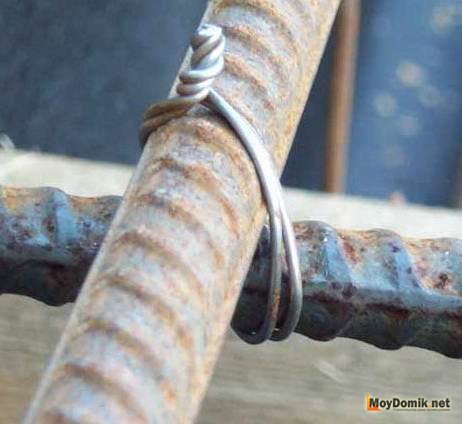
Knitting reinforcement with wireAn example of tying reinforcement with wire.
The example shows that the connection is made with wire. This is a relatively new approach to joining, since resistance welding is more common.
But methods of connecting reinforcement by welding have several significant disadvantages, including:
- require a welding machine and a specialist who can perform welding work;
- due to the high temperature of the welding arc, the strength of the hardened reinforcement rod is lost;
- welding work is not applicable for fittings with a diameter of more than 20 mm;
- The most important thing is to increase the rigidity of the reinforced frame. Since a shallow strip foundation “plays” depending on the season (being a kind of flexible foundation), increased rigidity will lead to its destruction. As a result, foundation repairs or complete replacement will be required.
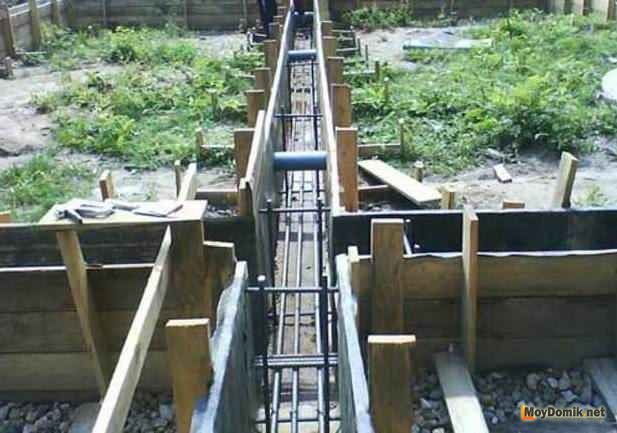
Laying reinforcement for a shallow foundation This is what the laid reinforcement will look like
Concrete protection
To avoid overdrying and the formation of cracks, the concrete poured into the formwork is covered with a film and periodically moistened with water.
Insulation of a shallow strip foundation
- Immediately after the foundation has gained the required strength, construction of the house should begin. Try to do all the work in one season. Because the soil under the foundation will freeze, and the MZLF, not pressed down by the weight of the house, will become deformed.
- If you cannot start construction, cover the MZLF and the area around it (200-300 mm) with straw or sawdust. To protect the soil from freezing.
- During the operation of the building, try to plant perennial plants and shrubs near the shallow strip foundation. They will help reduce the freezing depth of the soil. They will also be able to retain a significant amount of snow, which will also reduce the freezing depth.
When does it change stepwise?
When building a house on a site with a slope, a stepwise change in the depth of the foundation is necessary . In such cases, tape and column type structures are used.
Concrete tape is the most reliable. This type of foundation can be constructed on slopes with a slope of up to 28-35 degrees.
The essence of the stepped foundation is that the lower wall is a retaining wall and has an increased depth .
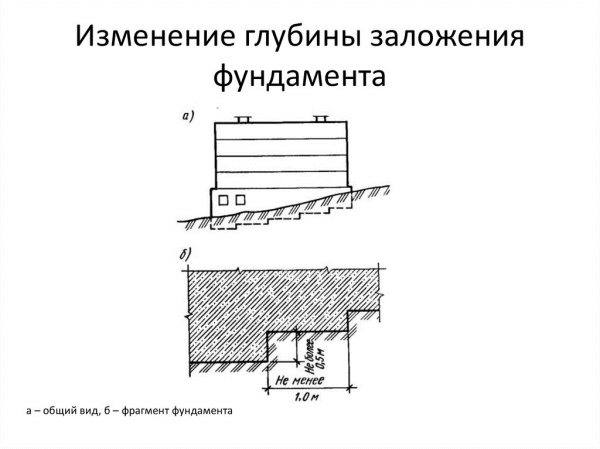
Its diagram is as follows: first, a trench is prepared for the upper wall with a depth equal to the calculated depth.
A trench of the same depth is dug under the lower retaining wall, but the formwork is raised to such a height that its upper boundary is strictly in the same horizontal plane with the upper cut of the formwork of the upper wall.
After pouring, a support slope is poured from the outside of the lower wall, and therefore the actual depth of the lower wall will be equal to the depth of the upper wall plus the height that compensates for the slope.
The side wall of the strip foundation in question has a stepped design . Its entire length is conventionally divided into sections of approximately 2 m. In each section, a horizontal trench bottom is formed. The starting point is to deepen the upper wall.
The structure of the side wall of a foundation on a slope can be illustrated with an example. For example, a house 6 m wide is being built on a slope with a slope of 15 degrees. Conventionally, we select 3 steps of the side wall, each 2 m long.
The steps must compensate for the slope, and the sole of each of them must be strictly horizontal. The starting point is located on the top, and the ending point is on the bottom wall, where the foundation depth is 0.8 m.
However, due to the slope, the end point is located below the top by 6xsin15=1.55 m . The height of each step will be 1.55:3 = 0.53 cm.
The upper step at the starting point will have a depth of 0.8 m, and at the final point – 0.8-2sin15=0.28 m. The lower step: at the final point – 0.8 m, and at the starting point – 0.8+sin15= 1.32 m. The middle step has a similar value.
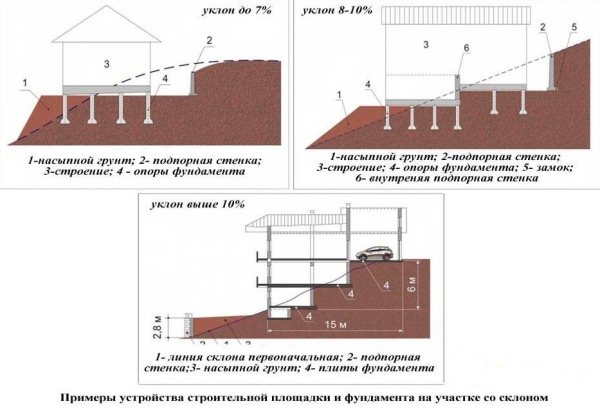
Using deep foundations for small buildings
It so happens that deep foundations are practically not used in the construction of low-rise buildings and buildings made of lightweight materials. There is a risk of construction defects due to insufficient shrinkage hardness of the soil. The structures of buildings of this type are lightweight. Therefore, for the construction of wooden cottages that are so popular today, it is unwise to use deep foundation technology.

Fig .: Low-rise buildings with deep foundations
In order to rationally use building materials, they resort to the method of laying a foundation on a sandy base. To arrange the latter, they resort to a multilayer coating, where each of them is wetted with water. With this approach, the foundation can have increased strength.
Set of rules
The rules for determining at what depth to make the foundation are established by SP 50-101.2004. They include the following basic requirements:
- It should be selected taking into account the main influencing factors (purpose of the structure, design features, geological and hydrological factors, seasonal freezing).
- The depth of soil freezing is taken taking into account the results of observation over a period of at least 10 years, as an average annual value.
- In the absence of tabular data for a specific calculation, a calculation is carried out taking into account the standard freezing of a certain type of soil.
- Determined separately for external and internal walls.
- It is adjusted taking into account the coefficient of influence of the operational features of the room.
- The base of a buried foundation should be located below the freezing depth of the soil, but above the groundwater level. The minimum depth of a shallow foundation is set taking into account the properties of the soil and takes into account the freezing depth.
- When designing the foundation, water-reducing (drainage) measures must be taken into account.
- When constructing a foundation on a slope, stepwise deepening is used to ensure the formation of a horizontal floor base.
- You should not dig according to the principle: the deeper, the stronger and more reliable. So you can just uselessly bury a lot of money in the ground. The foundation must be optimal for the given type of building.
The design rules are also specified by other regulatory documents indicated above. The characteristics of different types of foundation must be taken into account.

